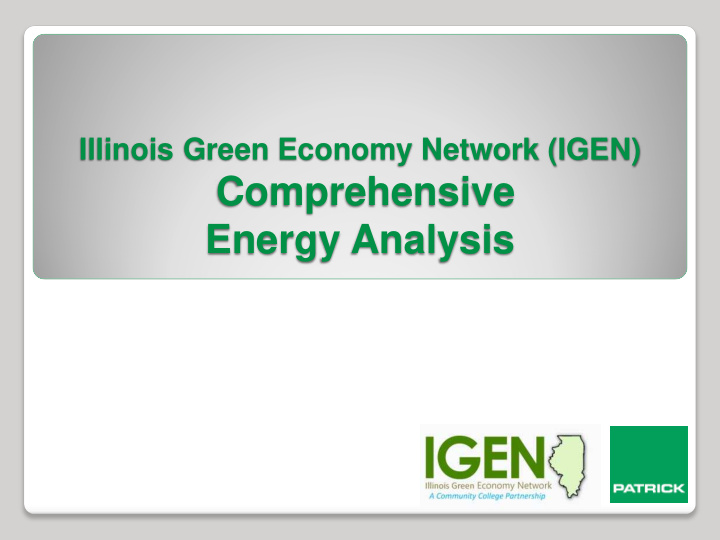



Illinois Green Economy Network (IGEN) Comprehensive Energy Analysis
IGEN Comprehensive Energy Analysis Funding Information Funding provided from the Illinois Department of Commerce and Economic Opportunity through a legislative appropriation in the state budget.
IGEN Comprehensive Energy Analysis Overview IGEN is conducting a comprehensive analysis of Illinois community colleges’ energy commodity purchasing, energy consumption/use management, and the potential for renewable energy asset development. Patrick Engineering, Inc. will summarize findings and identify opportunities to optimize energy procurement strategies, reduce utility consumption and reduce costs, and implement renewable technologies in a manageable and cost-effective way.
IGEN Comprehensive Energy Analysis IGEN Team Patrick Engineering Team Stephen Bell David Kramer Robert Hilgenbrink Gary Reed Katie Davis Ron Swager Ed Smith (Illinois Community College Chris Burger Board) Mark Pruitt (The Power Bureau)
IGEN Comprehensive Energy Analysis Progress • As of November 2013, 100% of the Illinois community colleges are participating in the energy analysis. • The energy analysis will be completed by March 2014.
IGEN Comprehensive Energy Analysis Status of Data Analysis and Report Content Developed master spreadsheet and began to populate/assimilate data 1. Determined core analysis metrics to support the objectives 2. Interfaced with potential commodity suppliers 3. Began consortium scenarios for optimal market leverage potential 4. Gathered applicable tariffs in the various service territories 5. Collected weather data, established tariff and utility rate models 6. Established applicable utility rate file structuring for renewables 7. Developed basic final report framework 8.
IGEN Comprehensive Energy Analysis Data Comparison Metrics Considered Peak vs. average kW and therm demand for winter/summer 1. BTU/square foot per year 2. $/square foot per year 3. Average daily consumption/average daily temperature 4. $/unit of energy (total) 5. $/unit of energy (distribution) 6. $/unit of energy (commodity) 7. Units of energy/student 8. Units of energy/credit hour 9.
IGEN Comprehensive Energy Analysis Potential Opportunities Electric distribution charges range from 1.8 to 2.5 cents per kWh Gas distribution charges range from 5.0 to 15 cents per therm Total electric charges for at least one campus metered site exceeds 29 cents per kWh Monthly gas charges for at least one campus vary from $0.46 to $1.76 per therm Costs in $/square foot vary from $1.35 to $2.50 per year Energy use in BTU/square foot range from 75,000 to 140,000 per year
IGEN Comprehensive Energy Analysis Commodity Procurement Analysis Objectives ◦ Create an understanding of energy consumption and demand at individual sites as well as in the aggregate ◦ Create models to reflect the potential costs and benefits of group commodity purchasing, reductions in energy consumption, and on-site generation Approach ◦ Modeling Statistical models established for each account on each site Energy costs separated into appropriate categories (commodity, transmission, distribution, taxes, account fees) Consumption levels and costs normalized for weather to establish a baseline Adjust models to reflect changes in costs, efficiency and on-site generation ◦ Evaluation Review supply contracts Establish range of efficiencies for separate elements (i.e. vendor margin, costs, commodity discounts)
IGEN Comprehensive Energy Analysis Commodity Procurement Analysis Contract characteristics ◦ Currently lacking supply contracts from majority of colleges ◦ Most contracts: Are structured around fixed price products (instead of variable rate offers) Contain terms and conditions more favorable to the suppliers Do not clearly identify the level of vendor margin embedded in the transactions Lack mechanisms to facilitate alternative pricing structures even when such changes could benefit the college Do not include options for reducing total energy costs (i.e. demand response) Potential opportunities from initial contract reviews ◦ Potential to reduce vendor margins from $2-3/MWh to $0.75-1.50/MWh for electricity ◦ Potential to reduce vendor margins from $0.010/therm to $0.005/therm for natural gas Total vendor margin savings potential and additional transaction cost reductions can be calculated as more data is provided by the colleges.
IGEN Comprehensive Energy Analysis Renewable Energy Development Areas of additional potential cost benefits ◦ Reduced peak capacity cost in ComEd service territory ◦ Reduced distribution capacity cost in Ameren service territory ◦ Reduced peak capacity cost in Municipal service territories ◦ Reduced distribution and transmission charges with on-site generation asset development ◦ Ground-coupled water-source heat pumps Feasibility of larger-scale centralized development will depend on the availability of load data from more colleges.
IGEN Comprehensive Energy Analysis Renewable Energy Development Potential CHP at location on a municipal served campus now averaging 14 cents per kWh Solar thermal for any all-electric and/or rural co-op campuses
IGEN Comprehensive Energy Analysis Timeline Report rough draft to IGEN for review: January 17, 2014 1. Final report to IGEN: March 21, 2014 2.
Recommend
More recommend